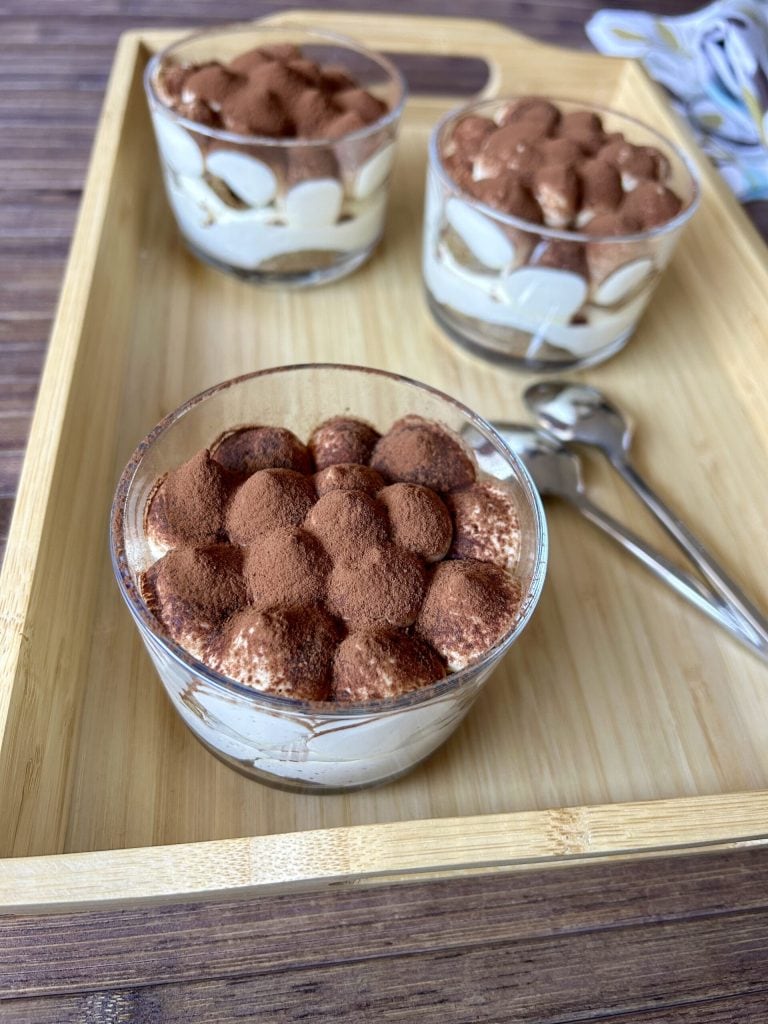Single-serving Tiramisu, rich with creamy layers made of eggs and mascarpone. A great interpretation of the classic tiramisu, more convenient for transport, presentation at the table, and very scenic for buffet setups. You can decide to prepare it in ceramic, terracotta, or glass jars; even better, use glass ones with lids to store it well in the fridge.
There are many versions of tiramisu with fruit, chocolate, pistachio, and whatever creativity suggests, but for this recipe, I chose to stick to the classic one.
We will use only three ingredients for the cream: eggs, sugar, and mascarpone. For added safety, you can choose to pasteurize the eggs while beating them. It’s not a difficult process; just beat both the yolks and whites in a bain-marie by placing the bowl in a pot of boiling water, keeping it on the stove. Personally, I did not follow this procedure but do not discourage it. Eggs pasteurize at a temperature of 140-149°F.
We are not adding whipped cream to the eggs, a procedure often used to prevent the egg whites from deflating. Well-beaten eggs won’t deflate for a couple of days in the fridge, so if the tiramisu is consumed fresh, there is absolutely no need to add whipped cream.
Important for well-beaten egg whites: ensure the whisks are very clean, therefore I first beat the egg whites to stiff peaks, then I proceed to beat the yolks with sugar and mascarpone. To add the egg whites to the yolk and mascarpone cream, do not use electric whisks but add them by hand, in at least two additions, with circular movements from bottom to top.
With these small precautions, you will see your egg whites remain beautifully compact, and your tiramisu cream will be very soft but won’t run, allowing you to create lovely decorative dollops on the surface.
For those who love homemade desserts, I also remind

- Difficulty: Very easy
- Cost: Cheap
- Preparation time: 25 Minutes
- Portions: 6
- Cooking methods: No bake
- Cuisine: Italian
- Energy 394.63 (Kcal)
- Carbohydrates 32.76 (g) of which sugars 14.33 (g)
- Proteins 8.55 (g)
- Fat 24.43 (g) of which saturated 10.96 (g)of which unsaturated 1.74 (g)
- Fibers 12.59 (g)
- Sodium 70.53 (mg)
Indicative values for a portion of 110 g processed in an automated way starting from the nutritional information available on the CREA* and FoodData Central** databases. It is not food and / or nutritional advice.
* CREATES Food and Nutrition Research Center: https://www.crea.gov.it/alimenti-e-nutrizione https://www.alimentinutrizione.it ** U.S. Department of Agriculture, Agricultural Research Service. FoodData Central, 2019. https://fdc.nal.usda.gov
Ingredients
Among the ingredients, you will find 200 ml of cold coffee; I suggest preparing a moka pot for six people in advance so you will have it ready and cooled for preparation.
- 3.5 oz ladyfingers
- 6.8 oz coffee (from moka, cold)
- 2 eggs
- 8.8 oz mascarpone
- 2 tbsps sugar (heaped)
Tools
To beat the eggs well, I recommend using an electric whisk. For the single servings, I recommend 6 oz glass bowls.
- 1 Electric whisk
- 6 Small bowls
Preparation
Making the tiramisu is very quick and requires no baking. My advice, as mentioned before, is to prepare the moka coffee pot for at least 6 people in advance, as it needs to cool down before being used.
The first step is to separate the eggs into two bowls. Put the whites in a glass bowl and, with the help of an electric whisk, beat them until stiff peaks form. They must be very well beaten; when you lift the whisks, the whites should remain attached to them. Now beat the yolks with the sugar and continue whisking until they are nicely fluffy and lightened. Add the mascarpone to the yolks, still using the electric whisk. If you see the mascarpone slightly deflate when adding it to the eggs, do not worry, keep whisking with the electric whisk, and it will become compact again. Finally, fold the beaten egg whites into the rest of the mixture, but this time do not use the electric whisk. The whites should be added by hand, at least in two batches, so as not to deflate them too much, using circular movements with a spoon or a silicone spatula, from bottom to top.
When your cream is ready, take the ladyfingers and break them in half as you use them. Dip the cookies in the coffee with a very quick motion because they need to absorb some coffee to cover the entire cookie, but they should not get too soaked. Place the coffee-soaked cookie at the bottom of the bowl, cover with some cream, place another half cookie soaked in coffee, and top with a second and final layer of cream.

To make your single servings even more scenic, I can suggest using a pastry bag to distribute the cream over the cookies. I mounted a plain nozzle on the bag and simply made circles of cream to cover the surface in the middle layer. On the top and final layer, I created small dollops of cream with the same nozzle.
Finally, before serving, I dusted with some bitter cocoa. If you want more generous layers of cream and want to fill the bowls more for all six, I recommend doubling the cream portion.

NOTES
You can prepare the tiramisu slightly in advance of when you plan to consume it, up to 24 hours. Otherwise, you risk the cookie, even though it is nice and sponge-like, slowly releasing the coffee. It remains good to eat but slightly less aesthetically pleasing.
To store it in the fridge, cover the bowls with plastic wrap and dust them with bitter cocoa only when you decide to consume it.
If you enjoyed the recipe or have any questions, feel free to comment here or on social media Facebook, Pinterest, Instagram and X.

